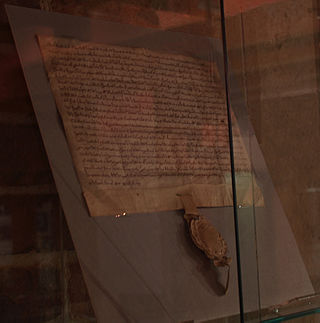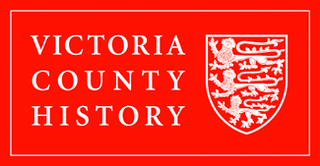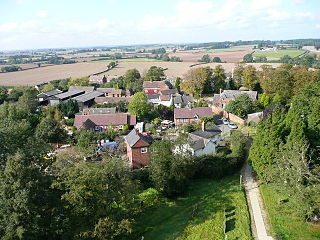Related Research Articles

Speen is a village and civil parish in West Berkshire, England. Centred 2 miles (3 km) north west of the largest town in the district, Newbury, Speen has clustered settlements, the largest of which is Speen village, which is contiguous with Newbury, and the others, buffered from the town by the A34 road, are Bagnor, Stockcross, Woodspeen and Marsh Benham. Its other land is an approximately even mixture of woodland and agricultural fields including hay meadows for livestock feed and pasture. The area varies greatly in elevation, having the Reading to Taunton Line alongside the north bank of the River Kennet as its southern boundary and both banks of the River Lambourn in its north with elevated ground in between. Benham Park in the south-west of the area is a listed landscape garden and house.

The Kingdom of Jerusalem, one of the Crusader states that was created in 1099, was divided into a number of smaller seigneuries. According to the 13th-century jurist John of Ibelin, the four highest crown vassals in the kingdom proper were the count of Jaffa and Ascalon, the prince of Galilee, the lord of Sidon, and the lord of Oultrejordain.

Sir William Longespée was an English knight and crusader, the son of William Longespée and Ela, Countess of Salisbury. His death became of significant importance to the English psyche, having died at the Battle of Mansurah, near Al-Mansurah in Egypt.

The double County of Jaffa and Ascalon was one of the four major seigneuries comprising the major Crusader state of the Kingdom of Jerusalem, according to 13th-century commentator John of Ibelin.
Speenhamland is an area within modern Newbury, Berkshire.
Wallingford Priory was a Benedictine priory dedicated to the Holy Trinity in Wallingford in the English county of Berkshire. Nothing remains of Holy Trinity Priory, which is believed to have stood on the site of the Bullcroft recreation ground off the High Street.

East Lockinge is a village and former civil parish, now in the parish of Lockinge, in the Vale of White Horse district, in the county of Oxfordshire, England. It was part of Berkshire until the 1974 local authority boundary changes transferred the Vale of White Horse to Oxfordshire. It is about 1.5 miles (2.4 km) east of Wantage, the village is included within the North Wessex Downs Area of Outstanding Natural Beauty (AONB). In 1931 the parish had a population of 227. On 1 April 1934 the parish was abolished to form "Lockinge".

The Wiltshire Victoria County History, properly called The Victoria History of the County of Wiltshire but commonly referred to as VCH Wiltshire, is an encyclopaedic history of the county of Wiltshire in England. It forms part of the overall Victoria County History of England founded in 1899 in honour of Queen Victoria. With eighteen volumes published in the series, it is now the most substantial of the Victoria County Histories.

East Hendred is a village and civil parish about 4 miles (6.4 km) east of Wantage in the Vale of White Horse and a similar distance west of Didcot. The village is on East Hendred Brook, which flows from the Berkshire Downs to join the River Thames at Sutton Courtenay. Historically in Berkshire, it has been administered as part of Oxfordshire, England, since the 1974 boundary changes. The westernmost parts of the Harwell Science and Innovation Campus are in the parish. The Ridgeway and Icknield Way pass through the parish. It was called "the most well connected village in Britain" because of its connections with the railway station in Didcot and the M4 motorway. Champs Chapel Museum of East Hendred is a small museum in a former 15th-century wayside chapel.

Avington is a village and former civil parish, now in the parish of Kintbury, in the West Berkshire district, in the ceremonial county of Berkshire, England. The village is on the River Kennet, just under 1 mile (1.6 km) northwest of Kintbury village and 2 miles (3 km) east of the town of Hungerford. The Kennet and Avon Canal follows the river and passes the village. In 1931 the parish had a population of 77. On 1 April 1934 the parish was abolished and merged with Kintbury.

James Bertie, 1st Earl of Abingdon, styled Hon. James Bertie until 1657 and known as the 5th Baron Norreys from 1657 until 1682, was an English nobleman.
Ela of Salisbury, 3rd Countess of Salisbury was an English peeress. She succeeded to the title in her own right in 1196 upon the death of her father, William FitzPatrick, 2nd Earl of Salisbury.

Clifton Campville is a village, former manor and civil parish in Staffordshire, England. It lies on the River Mease, about 10 miles (16 km) east of the City of Lichfield, 6 miles (10 km) west of Measham and 7 miles (11 km) north of Tamworth. The village lies close to Staffordshire's borders with Derbyshire, Leicestershire and Warwickshire. The parish, which includes Haunton village, had a population of 912 at the 2011 census. There is a fine gothic church, dedicated to St Andrew, and listed Grade I. The village pub, The Green Man, is also a historic building.
Gerard de Canville, often written Camville, was an Anglo-Norman landowner and administrator who was a loyal supporter of King Henry II of England and of his son King John, and through his wife obtained the posts of sheriff of Lincolnshire and constable of Lincoln Castle.
Richard Brydges (1500–1558) was an English politician.
Rev. Peter Hampson Ditchfield, FSA was a Church of England priest, historian and prolific author. He is notable for having co-edited three Berkshire volumes of the Victoria County History which were published between 1907 and 1924.

Idstone is a hamlet in the civil parish of Ashbury in the Vale of White Horse. Idstone was part of Berkshire until the 1974 boundary changes transferred the Vale of White Horse to Oxfordshire. Idstone is about 6 miles (10 km) east of Swindon in neighbouring Wiltshire.
Gervais, Count of Rethel was a French archbishop and nobleman. He was the son of Count Hugh I and his wife Melisende of Crécy. He succeeded his father as Count of Rethel.

There have been four different baronies held by the Marmion family, two feudal baronies, one purported barony created by Simon de Montfort and one barony by writ.

Baron Camville was a title created in the Peerage of England for Geoffrey de Camville II, of Clifton Campville in Staffordshire, who having been summoned to Parliament on 24 June 1295 and subsequently, by writs directed to Galfrido de Caunvilla, Caumvilla, Canvilla or Camvilla, was deemed thereby to have been created Baron Camville.
References
- 1 2 Setton, Kenneth Meyer; Wolff, Robert Lee; Hazard, Harry W (2006). The Later Crusades, 1189–1311. A History of the Crusades. Vol. II (2nd ed.). University of Wisconsin Press. pp. 56, 64. ISBN 978-0-299-04844-0 . Retrieved 11 December 2009.
- ↑ Rigg, James McMullen (1886). . In Stephen, Leslie (ed.). Dictionary of National Biography . Vol. 8. London: Smith, Elder & Co. p. 408.
- 1 2 Crowley, D A, ed. (2002). "Calne". A History of the County of Wiltshire. Victoria County History. Vol. 17. pp. 17–27. Retrieved 12 November 2009.
- 1 2 Crossley, Alan; Elrington, C R, eds. (1990). "Wootton Hundred (South) including Woodstock". A History of the County of Oxford. Victoria County History. Vol. 12. pp. 274–281. Retrieved 12 November 2009.
- ↑ Page, Willam; Ditchfield, P H, eds. (1924). "Parishes: Speen". A History of the County of Berkshire. Victoria County History. Vol. 4. pp. 97–110. Retrieved 12 November 2009.
- ↑ Page, Willam; Ditchfield, P H, eds. (1924). "Parishes: Avington". A History of the County of Berkshire. Victoria County History. Vol. 4. pp. 158–162. Retrieved 12 November 2009.